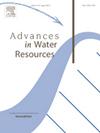Visualization experiment for characterizing the influence of an open fracture on CO2 behavior in fractured porous media
IF 4
2区 环境科学与生态学
Q1 WATER RESOURCES
引用次数: 0
Abstract
While gas behavior influenced by the intricate interplay between fractures and the surrounding porous media can create complex flow paths and distribution, there is a scarcity of experimental research focusing on the influence of a fracture on gas behavior due to the limitation of implementing an open structure within porous media. In this study, we have implemented transparent porous structures embedding an open fracture in porous media by using a 3D printer. The study encompasses a series of experiments to visualize and quantify the spatiotemporal distribution of gaseous and dissolved CO2 concentration by high-resolution pixel-wise image analysis. Results show that the presence of an open fracture significantly influences the behavior of CO2, affecting both the migration and distribution of gas and dissolved CO2 concentration. In addition, capillary fingering can be the trigger of early breaching across the fracture into the upper matrix which can create a highly discontinuous and heterogeneous spatiotemporal CO2 distribution. The implications of this research are not limited to CO2 behavior but extend to other gases and immiscible contaminants such as non-aqueous phase liquid whose behavior is different from that of groundwater. Our results suggest the applicability of the 3D printing technique in visualization experiments and the importance of incorporating detailed geological structures into environmental monitoring and predictive models for an effective environmental management.
打开裂缝对裂缝性多孔介质中CO2行为影响的可视化实验
虽然受裂缝与周围多孔介质之间复杂的相互作用影响的气体行为会产生复杂的流动路径和分布,但由于在多孔介质中实现开放结构的限制,缺乏专注于裂缝对气体行为影响的实验研究。在这项研究中,我们使用3D打印机在多孔介质中实现了嵌入开放裂缝的透明多孔结构。该研究包括一系列实验,通过高分辨率像素图像分析可视化和量化气体和溶解二氧化碳浓度的时空分布。结果表明:开放裂缝的存在显著影响CO2的行为,既影响气体的运移和分布,也影响溶解CO2浓度。此外,毛细指动可以触发裂缝早期突破进入上部基质,从而产生高度不连续和非均匀的CO2时空分布。本研究的意义不仅限于CO2的行为,还扩展到其他气体和非混相污染物,如非水相液体,其行为与地下水不同。我们的研究结果表明了3D打印技术在可视化实验中的适用性,以及将详细的地质结构纳入环境监测和预测模型的重要性,以实现有效的环境管理。
本文章由计算机程序翻译,如有差异,请以英文原文为准。
求助全文
约1分钟内获得全文
求助全文
来源期刊

Advances in Water Resources
环境科学-水资源
CiteScore
9.40
自引率
6.40%
发文量
171
审稿时长
36 days
期刊介绍:
Advances in Water Resources provides a forum for the presentation of fundamental scientific advances in the understanding of water resources systems. The scope of Advances in Water Resources includes any combination of theoretical, computational, and experimental approaches used to advance fundamental understanding of surface or subsurface water resources systems or the interaction of these systems with the atmosphere, geosphere, biosphere, and human societies. Manuscripts involving case studies that do not attempt to reach broader conclusions, research on engineering design, applied hydraulics, or water quality and treatment, as well as applications of existing knowledge that do not advance fundamental understanding of hydrological processes, are not appropriate for Advances in Water Resources.
Examples of appropriate topical areas that will be considered include the following:
• Surface and subsurface hydrology
• Hydrometeorology
• Environmental fluid dynamics
• Ecohydrology and ecohydrodynamics
• Multiphase transport phenomena in porous media
• Fluid flow and species transport and reaction processes
 求助内容:
求助内容: 应助结果提醒方式:
应助结果提醒方式:


